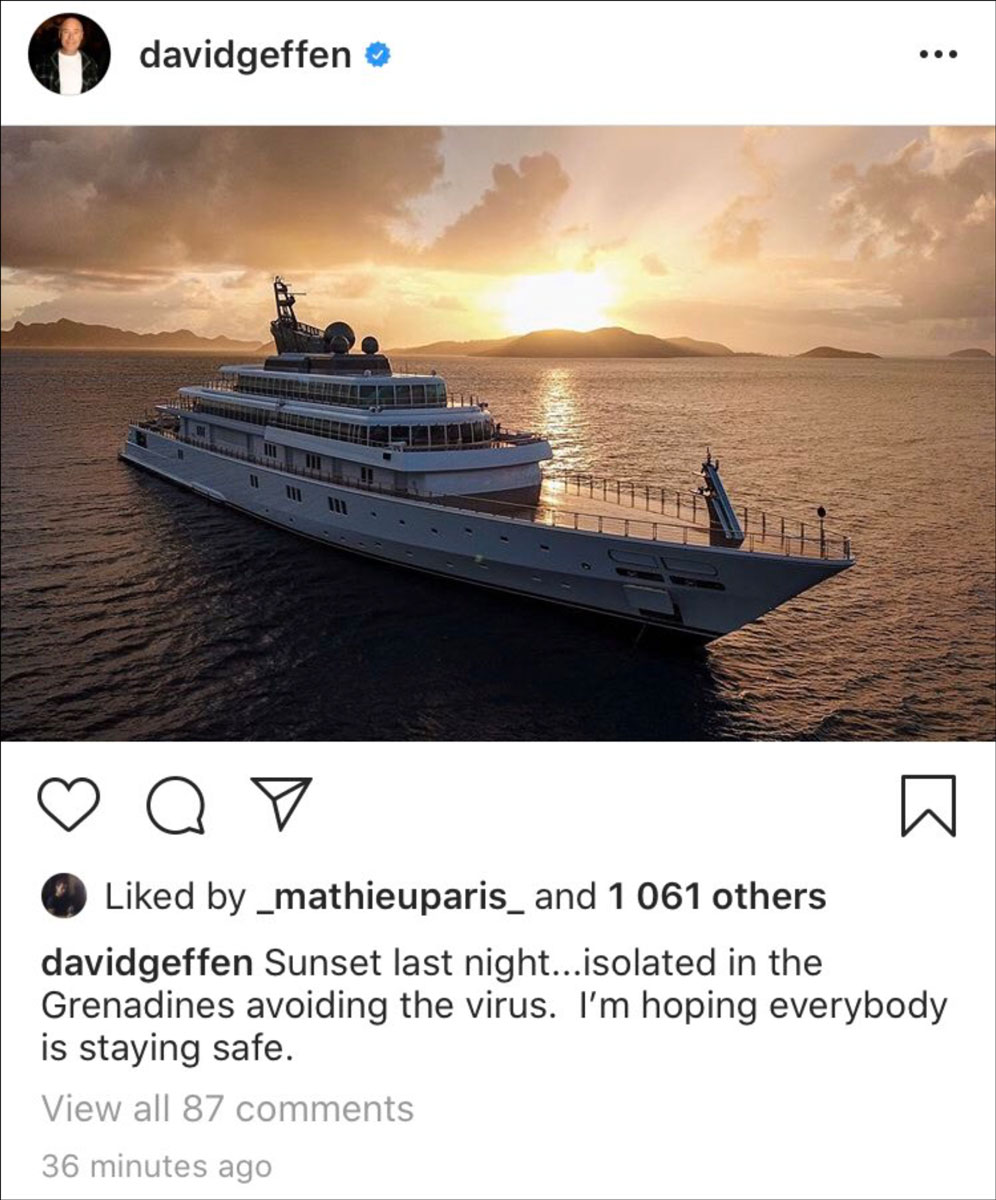How sick and twisted is a society where grocery clerks make $12-15 per hour working on the frontline, risking their lives and getting sick to feed America, while the 1% abuse government bailouts?
 DreamWorks co-founder David Geffen created a social media firestorm on March 28 when he posted a photograph of his $590-million mega-yacht on Instagram with the words, “Sunset last night…isolated in the Grenadines avoiding the virus. I’m hoping everybody is staying safe.” For a former music producer, Geffen is quite tone-deaf.
DreamWorks co-founder David Geffen created a social media firestorm on March 28 when he posted a photograph of his $590-million mega-yacht on Instagram with the words, “Sunset last night…isolated in the Grenadines avoiding the virus. I’m hoping everybody is staying safe.” For a former music producer, Geffen is quite tone-deaf.
Wealth Accumulation
Between 1983 and 2016, the share of U.S. aggregate wealth held by upper-income families increased from 60% to 79%. In comparison, the share of wealth held by middle-income families has been cut nearly in half, falling from 32% to 17%.
How did the rich get so wealthy? As The Collapse of Business Ethics explains, between 2008 and 2019, U.S. corporations spent more than $6 trillion buying back their own stock, money that largely ended up in the pockets of wealthy investors. And since the wealthiest 10% of American households control more than 80% of household stock ownership, the U.S. middle-class and the poor received next to nothing.
The CARES (Coronavirus Aid, Relief, and Economic Security) Act accelerates that “enriching the rich” process by surrounding the U.S. Treasury and Federal Reserve with a smokescreen, which, in effect, shields a $4.5 trillion hedge fund that protects corrupt corporations and bankrupt bond brokers with bail outs paid for by our tax dollars.
Wealth Concentration
Even the rich 10%, however, must tip their hat to the ultra-rich, the top 1%. In 2017, the top 1% increased their total global wealth 6% to a staggering $280 trillion, the fastest wealth creation since 2012, reports Credit Suisse.
According to the Economic Policy Institute’s The New Gilded Age report, the top 1% take home 21% of all income in the United States, the largest share since 1928. To be in the top 1% nationally in 2015, a family needed an income of $421,926.
Adds the Economic Policy Institute:
The rise of top incomes relative to the bottom 99% represents a sharp reversal of the trend that prevailed in the mid-20th century. From 1928 to 1973, the share of income held by the top 1% declined in every state for which we have data. This earlier era was characterized by a rising minimum wage, low levels of unemployment after the 1930s, widespread collective bargaining in private industries (manufacturing, transportation, telecommunications, and construction), and a cultural, political, and legal environment that kept a lid on executive compensation in all sectors of the economy.
That sharp reversal has led to a world with 2,095 billionaires, down 58 from a year earlier, with a combined net worth of a mind-numbing $8 trillion.
In America, the value of assets for all U.S. households increased from 1989 through 2016 by an inflation-adjusted $58 trillion. A full 33% of that gain, $19 trillion, went to the wealthiest 1%, according to a Wall Street Journal analysis of Fed data.
All this wealth was not earned via the value creation — it was skimmed and embezzled from the bottom 95% via government bailout of banks and Wall Street; excessively high healthcare costs; “resort fees;” bankster penalties; excessively low-interest loan rates and tax givebacks to the wealthy — all influenced by control-freak monopolies and cartels unburdened by competition, accountability or transparency.
Welcome to Richy Rich-land.
Read more:
- Income inequality – 61% of adult Americans told Pew that there is “too much” income inequality in the U.S., and 42% said reducing income inequality should be a “major priority” for the federal government. No surprise since the income of the 1% more than doubled between 1973 and 2010, going from about 8% to 17% of all income. Not persuasive enough? How about the richest 400 Americans owning more than the bottom 150 million?
- Income inequality worse than illegal immigration – Marketwatch (11-Jan-20): Americans say income inequality is a bigger problem than illegal immigration
- The Washington Post (26-Sep-19): Income inequality in America is the highest it’s been since Census Bureau started tracking it, data shows
- Economic Policy Institute (14-Aug-19): CEO compensation has grown 940% since 1978
- Bloomberg (18-Dec-18): A Year After the Middle Class Tax Cut, the Rich Are Winning
- CNBC (22-Jan-18): CEOs make $15.6 million on average—here’s how much their pay has increased compared to yours over the year
- CNBC (14-Nov-17): Richest 1% now owns half the world’s wealth
- Chicago Booth Review (2017): Never mind the 1 percent Let’s talk about the 0.01 percent
- Economic Policy Institute (26-Jun-13): CEO Pay in 2012 Was Extraordinarily High Relative to Typical Workers and Other High Earners
